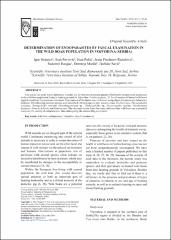| dc.contributor.author | Stojanov, Igor | |
| dc.contributor.author | Pavlović, Ivan | |
| dc.contributor.author | Pušić, Ivan | |
| dc.contributor.author | Prodanov-Radulović, Jasna | |
| dc.contributor.author | Ratajac, Radomir | |
| dc.contributor.author | Marčić, Doroteja | |
| dc.contributor.author | Savić, Božidar | |
| dc.date.accessioned | 2019-12-18T09:29:40Z | |
| dc.date.available | 2019-12-18T09:29:40Z | |
| dc.date.issued | 2018 | |
| dc.identifier.issn | 1409-7621 | |
| dc.identifier.uri | https://repo.niv.ns.ac.rs/xmlui/handle/123456789/223 | |
| dc.description.abstract | The aim of our study was to determine whether and to what extent certain species of helminths and protozoa are present
in the wild boar population living in hunting grounds in Vojvodina. For this purpose, 52 faecal samples of hunted wild boars
(aged 6 months to 2 years) were examined. Examination of the faeces was performed using classical coproscopic laboratory
methods. The following parasite species were identified: Metastrongylus spp. Ascaris suum, Trichuris suis, Physocephalus
sexalatus, Strongyloides ransomi, Oesophagostomum sp. / Globocephalus sp., Hyostrongylus rubidus, Gnathostoma
hispidum, Eimeria deblecki and Eimeria suis. The obtained results from this study indicated that wild boars are a potential
reservoir of a variety of endoparasites, thus endangering the surrounding ecosystem. | en_US |
| dc.description.sponsorship | This investigation was financially supported by the Ministry of Education, Science and Technological Development, Republic of Serbia, Project No. TR 31084 | en_US |
| dc.language.iso | en | en_US |
| dc.source | Macedonian Veterinary Review | en |
| dc.subject | wild boar | en_US |
| dc.subject | endoparasites | en_US |
| dc.subject | Vojvodina | en_US |
| dc.subject | faecal examination | en_US |
| dc.title | Determination of endoparasites by faecal examination in the wild boar population in Vojvodina (Serbia) | en_US |
| dc.type | Article | en_US |
| dc.identifier.doi | 10.1515/macvetrev-2017-0029 | |

